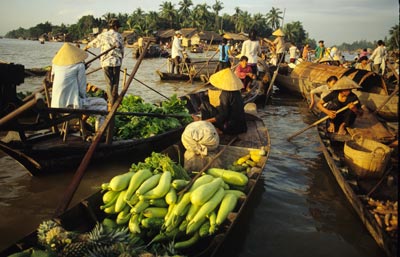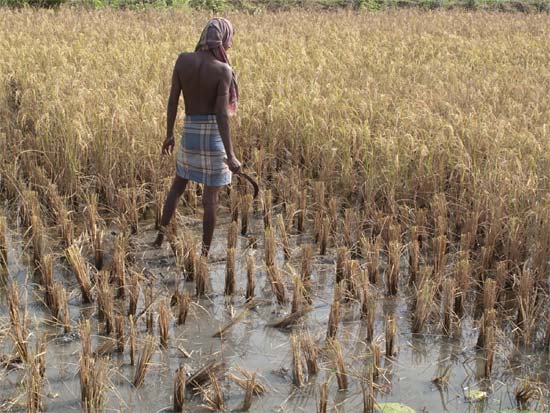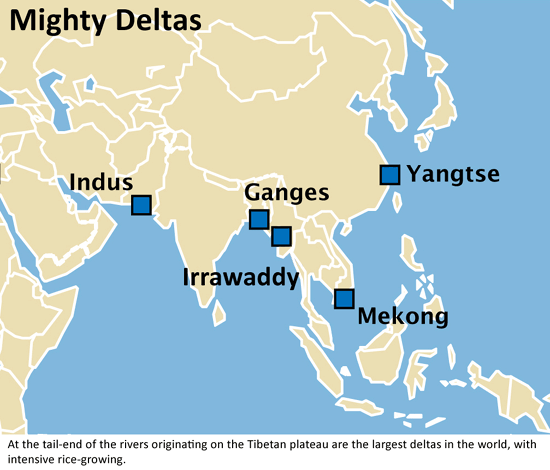
the Nations Downstream
- Can you name three major deltas at the tail-ends of rivers sourced in Tibet?
- Why are Tibet's rivers so important to the nations of South Asia?
- Roughly what population of South Asia do Tibet's rivers serve for irrigation, drinking water and other uses?
- In recent years, nations like India and Bangladesh have experienced extreme weather patterns, such as late monsoons and coastal cyclones. Is this extreme weather related to meltdown of glaciers in Tibet?
- Rivers sourced in Tibet flow into 11 nations downstream. Which nations?
MIGHTY DELTAS
At the tail-end of the rivers source in Tibet lie the biggest deltas in the world, where water is consumed in large quantities—particularly for the growing of rice. These are the rice-baskets of Asia:
- The Indus Delta—major agricultural zone for Pakistan
- The Ganges/Brahmaputra Delta—agricultural heartlands of India and Bangladesh
- the Irrawaddy Delta—major rice producer for Burma
- The Mekong Delta—major rice producer for Vietnam
- Yangtse River Delta—intensive rice growing and inland fishing region close to Shanghai
Most of the world's rice is grown and consumed in Asia. It takes 250 to 600 gallons of water to grow a pound of rice. Or in metric terms, around 2,000 to 4,500 litres of water to grow a kilo of rice.
WHERE WILL THE WATER COME FROM?
Demand for water for agricultural use in Asia expected to skyrocket
A UN report presented in Stockholm, Sweden, on August 17, 2009, predicts that demand for food and feed in Asia will double by the year 2050. That estimate does not take into account the possible impact of global warming on water supplies, nor the impact of dams. Asia's population is forecast to increase by 1.5 billion people over the next 40 years.
Scientists have warned Asian countries that they face chronic food shortages and likely social unrest if they do not improve water management. The water experts at a UN-sponsored conference in Sweden say countries in south and east Asia must spend billions of dollars to improve antiquated crop irrigation to cope with rapid population increases. The findings are published in a new joint report by the UN Food and Agricultural Organisation and the International Water Management Institute (IWMI). They suggest that Asian countries will need to import more than a quarter of their rice and other staples to feed their populations.
"Asia's food and feed demand is expected to double by 2050," said IWMI director general Colin Chartres. "Relying on trade to meet a large part of this demand will impose a huge and politically untenable burden on the economies of many developing countries.
"The best bet for Asia lies in revitalising its vast irrigation systems, which account for 70% of the world's total irrigated land," he said. With new agricultural land in short supply, the solution, he said, is to intensify irrigation methods, modernising old systems built in the 1970s and 1980s. But that, he says will require billions of dollars of investment.
'Scary scenarios'
At the same time as needing to import more food, the prices of those cereals are likely to continue to rise due to increasingly volatile international
markets. The report says millions of farmers have taken the responsibility for irrigation into their own hands, mainly using out-of-date and inefficient
pump technology. This means they can extract as much water as they like from their land, draining a precious natural resource.
"Governments' inability to regulate this practice is giving rise to scary scenarios of groundwater over-exploitation, which could lead to regional food crises and widespread social unrest," said the IWMI's Tushaar Shah, a co-author of the report. Asian governments must join with the private sector to invest in modern, and more efficient methods of using water, the study concluded. "Without water productivity gains, south Asia would need 57% more water for irrigated agriculture and east Asia 70% more," the study found. "Given the scarcity of land and water, and growing water needs for cities, such a scenario is untenable," it said. The scenarios forecast do not factor in the impact of global warming, which will likely make rainfall more erratic and less plentiful in some agricultural regions over the coming decades.

Rice harvesting in Bangladesh
